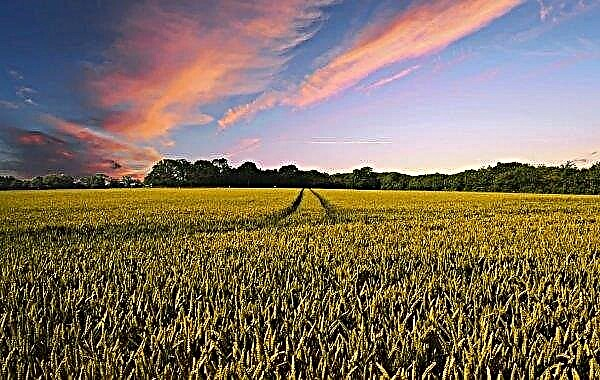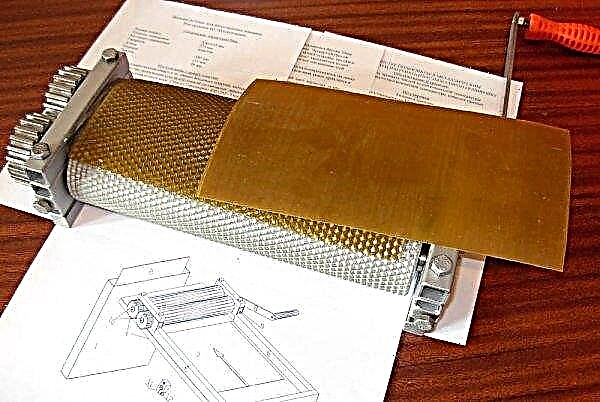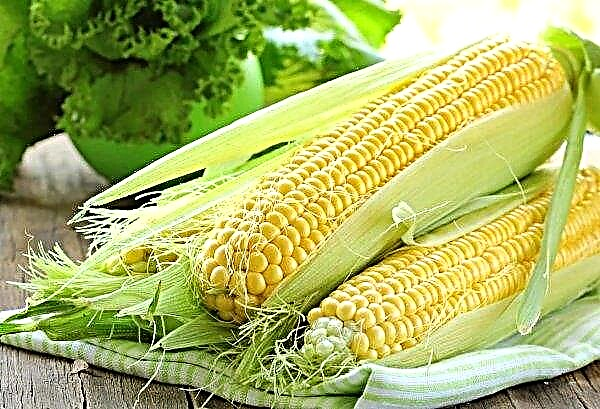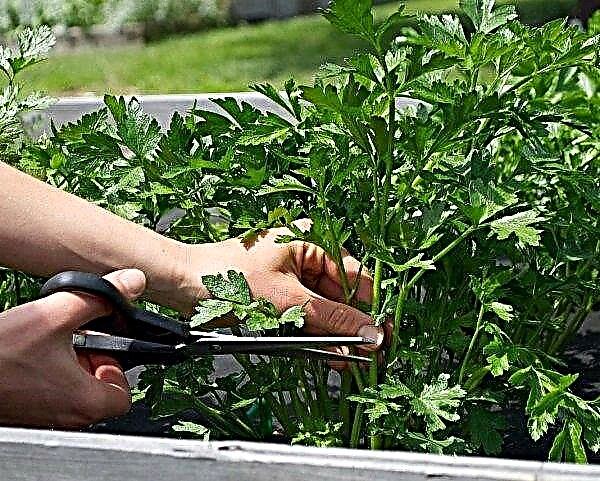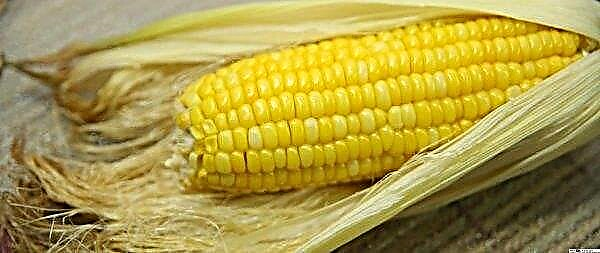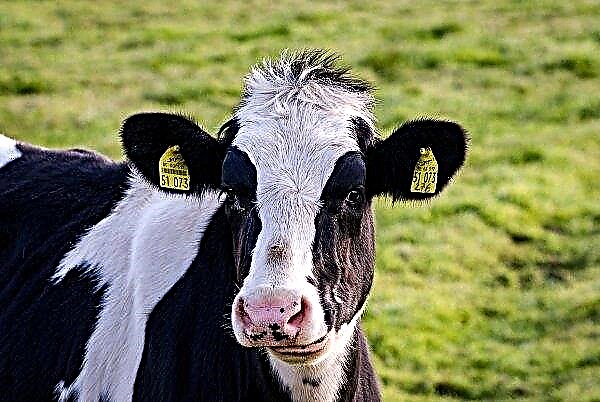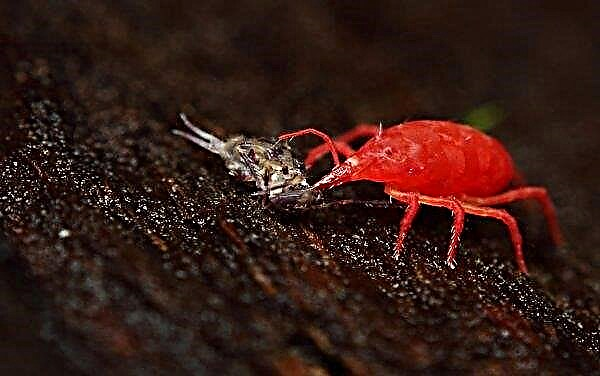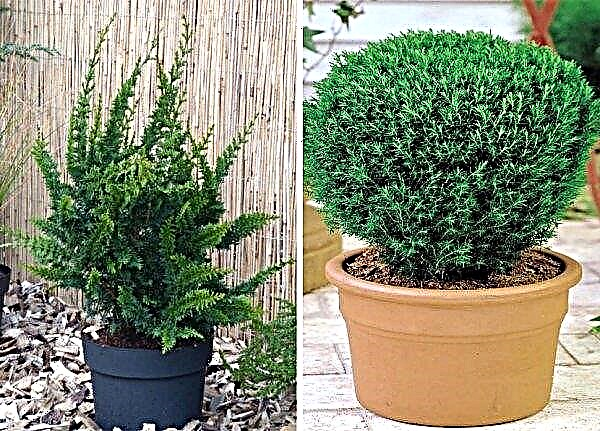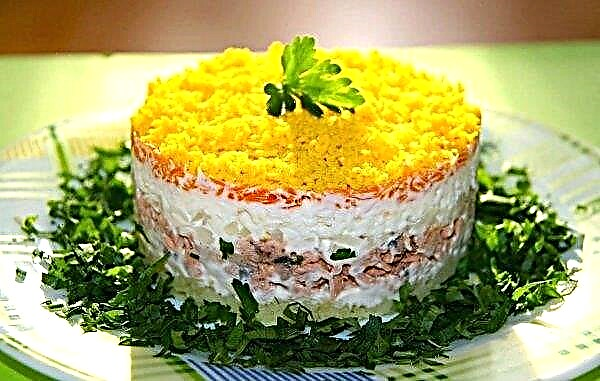An evergreen plant is a wonderful decoration for any site. It creates a unique microclimate, filling the air with useful substances and purifying it. Such a plant will survive in the harshest climate and will not lose its beauty. Popular is the creation of compositions in landscape design using the evergreen beauty of pine. The article will discuss the cultivation of mountain pine.
Description and dimensions of the tree
Mountain pine - coniferous plant, tree or multi-stemmed branched shrub. Usually not very high (up to 7–8 m), but sometimes it reaches 10 m. The branches and the trunk are covered with gray-brown scaly bark, which peels unevenly. Noticeable species characteristic: the shade of the bark is uneven throughout the tree.

From below it is darker than from above. Young shoots are initially light green, then turn dark brown, and then completely purple-brown. The needles are dark green, slightly glossy, densely covers the shoots. The needles are slightly twisted or bent.
The flowering period falls at the end of May - beginning of June. At this time, the plant is greatly transformed. Near the base there are beautiful yellow and pink male spikelets that adorn the bush. Female cones open on a short straight leg. Cones are single or paired, triple. They are 2–7 cm long and 1.5–2 cm wide. The seeds in them are small, dark, ovate. Cones ripen at the end of next year. Only pine trees older than 6–10 years old can bloom and bear fruit. Mountain pines live for about 1000 years.Did you know? In the world there are about 200 species of pines, half of which grows in Russia.
Video: The best varieties of mountain pines
How fast is growing
Conifers grow slowly. Specialists divided the existing varieties of mountain pine into groups according to the growth rate:
- full-grown - add 30 cm per year and at 10 years rise more than 3 m above the ground;
- semi-dwarf - add annually 15-30 cm;
- dwarf - 8-15 cm / year;
- miniature - 3–8 cm / year;
- microscopic - less than 1-3 cm / year.
Did you know? Southeast Asia is famous for its Bunge pine. Her bark is white.
How to care
Coniferous plants are unpretentious. They are used to surviving in various conditions, but in order for them to take root more quickly on a suburban area, they need to be properly looked after. Pine is irrigated three times per season. Under one tree, you need to pour 15-20 liters of water. If the near-stem circle is very tight, then it must be loosened before watering. When spring planting in hot and dry summers, it is necessary to irrigate the tree more often. You can use conventional sprinklers.
Within 2-3 years after planting, annual fertilizers must be applied annually in early spring (30-40 g per pine). You can use special fertilizers for conifers. An adult tree does not need recharge.
Its fallen needles will serve as a source of necessary substances. In order for the pine to grow slowly and in the right direction, it is necessary to trim the shoots. So the crown will become more dense. Young shoots pinch a third of the length.
What soil to use
In nature, mountain pine is used to sandy or sandy loamy soil. It has a slightly acid reaction (6–7 pH). Moisture should not stagnate at the landing site. If the site has heavy clay soil, or groundwater is located close to the surface, be sure to drain the planting pit with a good layer of expanded clay or broken brick.

Species and varieties
Mountain pine native to the mountains of Central and Southern Europe. Usually this tree is about 200 cm tall. But there are some varieties of this plant, significantly different in size and shape.
Alpine
Alpine pine - the owner of creeping shoots and small branches that look up. Such their arrangement gives the bush splendor. Saturated green, hard needles densely cover the plant. In the fifth or sixth year, tiny brown cones appear on the shrubbery. This type of pine grows well in rock gardens or in hedges around the house.
Important! When planting pine on a desert terrain, the Kornevin solution must be poured into the hole, and a month later fertilizers for conifers should be added.
Dwarf
The owner of the spherical crown. The growth is uniform and not fast, therefore it can rarely grow more than 150 cm. It can add 2–5 cm per year. The species practically does not bear fruit, therefore it propagates by cuttings.
His needles are dark green, shiny. Shoots are short, but thick and hard. Perfectly adapted to growth in a city. Loves the sun, withstands high humidity, drought-resistant. It tolerates haircuts, in comparison with other species, which makes the bush an indispensable element of landscape design. Planted individually or in groups.
Video: Dwarf mountain pine
Liliput
Dwarf tree with a hemispherical crown. She is very dense. An adult shrub of 10 years of age with a height of not more than 50-60 cm. Moreover, the diameter of its crown is 100 cm. The plant adds 2-4 cm per year. Its needles are short and stiff. He loves sunlight and fresh, drained soil. Liliput pine should preferably be used in small heather or rocky gardens.

Kobold
A dwarf shrub of about 100 cm in height, spherical in shape with thick branches. His kidneys appear in groups of 3-5, located at a distance from each other and have different lengths. They are thick, dull at the end, brown.
The needles are straight, long (20–35 mm) and thin (1 mm) of bright green color. Propagated by seeds, cuttings and grafting. Very winter hardy. It is recommended to plant in containers for landscaping roofs and rock gardens.
How to propagate a pine
Pine is propagated by seeds and grafts. Cuttings root extremely poorly (8–10%). To collect the seed, you need to wait until the tree is 6 years old. Small bumps appear at the end of autumn once every two years. Seeds are collected, dried, and then planted in spring in pots with a sandy substrate. Soil must be pre-treated with fungicides.
Did you know? Pinus is the Latin name for pine, which literally translates as “rock”. And all because the plant is able to fix its roots even on bare stones.
Vaccines are harvested in April. The vaccination procedure can be carried out in spring or summer, in August. In spring, a sleeping scion is grafted onto a stock that has moved to growth. The grafted plant may be in a greenhouse or open ground.
It is necessary to wait for the start of sap flow (the appearance of candles). Conifers are grafted into the butt. The junction is tightly wound. After an obvious start to the growth of the scion, the winding can be loosened, and after a few months completely removed. If such a plant successfully survives the winter, then we can say that the grafting process was successful.
Planting and growing
Mountain pine seedling grown in a container should be planted in the period from mid to late spring or from late September to early October. Later in the fall, it is highly undesirable to plant, because a young plant will not have time to grow stronger before severe frosts.
In order for the planted plant to quickly take root and not cause problems in the future, but only please the eye, you need to adhere to some planting rules. An ideal place for a plant is well-lit areas of the garden. Light penumbra is acceptable. In the shade, the photophilous bush will not stop growing, but it will be very slow.Important! According to experienced experts, for the southern regions the optimal planting time is autumn, and for the middle zone and northern regions - early spring.
 a - graft for vaccination with the needles removed; b - holding a cut on the handle; c - a cut is prepared on the handle; g - conducting a cut on the apical shoot of the stock; d - a cut is prepared on the shoot of the stock; e - the handle is laid on the exposed cambium of the stock; g - the cuttings are pressed in rare turns to the cut on the shoot of the rootstock; h - finished vaccination; C is the naked core; K - naked cambium; N - thread, sandwiched between a finger and a handle; Н1 - the end of the strapping; Measure the distance from the selected place to the foundation of the house. Must be at least 5 m so that the root system cannot destroy the structure. Only a columnar or reinforced monolithic foundation can withstand the pressure. It’s good if you have a rocky garden in your summer cottage where other conifers grow.
a - graft for vaccination with the needles removed; b - holding a cut on the handle; c - a cut is prepared on the handle; g - conducting a cut on the apical shoot of the stock; d - a cut is prepared on the shoot of the stock; e - the handle is laid on the exposed cambium of the stock; g - the cuttings are pressed in rare turns to the cut on the shoot of the rootstock; h - finished vaccination; C is the naked core; K - naked cambium; N - thread, sandwiched between a finger and a handle; Н1 - the end of the strapping; Measure the distance from the selected place to the foundation of the house. Must be at least 5 m so that the root system cannot destroy the structure. Only a columnar or reinforced monolithic foundation can withstand the pressure. It’s good if you have a rocky garden in your summer cottage where other conifers grow.Important! When planting several pines, you must observe a distance of 150 between them–200 cm.
Step-by-step description of the tree planting process:
- Prepare a landing pit. It should be comparable to the size of the earthen coma in which the seedling is in the container. Optimally, if it turns out to double the pit. If not, add 15–30 cm in diameter and 20–40 cm to the depth.
- Prepare the substrate: turf land, peat, river sand (3: 1: 1). You can add a little complex fertilizer (20-30 g). The soil mixture should be well mixed.
- Lay out the bottom of the pit with drainage, on top with prepared soil.
- Carefully remove the young bush from the container and, without shaking the ground, put it in a hole. The root neck cannot be deepened. If it is obtained below the soil level, then it should be poured into the soil pit.
- Sprinkle the soil with the mixture and carefully tamp. Form a trunk circle and sprinkle abundantly from a watering can.
- Lay a layer of peat 5-10 cm to retain moisture.

If you have patience, then you can grow young pine from seeds. They can be sown both at home in pots and immediately into open soil. Immediately into the ground, it is advisable to plant after thawing the earth to a depth in the bayonet of a shovel. For home growing seedlings, sowing is carried out at the end of winter in containers with a depth of 15–20 cm. They must be filled with calcined soil mixture from turf soil, peat and sand.
The seeds are buried by 2-3 cm, irrigated plentifully and covered with a film. Care must be taken to keep the soil moist. With the advent of seedlings, the tank must be opened and moved to a well-lit place. For sanitary purposes, young pine need to be sprayed with fungicides a couple of times. In early June or September, it can be planted in the soil, covered with a spruce for the winter.
Sowing in open soil is carried out in trenches with a depth of 1.5–2 bayonet shovels and a width of 20–25 cm, pre-filled with a mixture of sand and turf land (1: 2). 30 mm deep grooves are made in trenches. The seed must be deepened by 2 cm and sprinkled with sand on top. During the first week, you need to water the crops a couple of times a day so that the soil does not dry out.
Starting from the eighth day, watering is gradually reduced. In two to three weeks, seedlings should appear. They must be protected from direct sunlight. Once a week, to protect against fungal ailments, you should spray with a solution of potassium permanganate (the necessary condition is pink).
It is advisable to transplant in the fifth year of life. By this time, their height will be about 0.5 m. In winter, all young trees need to be covered with spruce branches.
Pests and diseases
All plants that have needles instead of foliage have good resistance to diseases and pests. But often under attack of adversity young trees fall. They are negatively affected by birds, weather conditions, improper care. In a weakened state after winter or a very wet summer, pine is affected by a fungal disease - shute.
You can stop the spread of infection by treatment with copper-containing drugs. All affected parts of the plant are removed and burned. For preventive purposes, during wet and hot summers, shrubs are sprayed with colloidal sulfur. Because of it, the needles become brown to a black dot, the branches often dry out and become covered with a spider web. The reason for this lies in insufficient moisture and lack of nutrients. A sick tree may not look decorative at all, as it often loses a lot of needles.
Because of it, the needles become brown to a black dot, the branches often dry out and become covered with a spider web. The reason for this lies in insufficient moisture and lack of nutrients. A sick tree may not look decorative at all, as it often loses a lot of needles.
Another problem is scleroderriosis. It leads to the fact that at the top of the branches the buds begin to die, and then the branches themselves. Sick parts of the evergreen beauty must be cut off.
Northerner - a disease that causes the appearance of an orange coating on the ends of the needles. The reason for it is a rust mushroom. You can defeat it only by the complete removal of the affected bushes.
Aphids are a common pest that spoils the beautiful appearance of pine. It is expelled with special drugs like Lepidocide. Be sure to carefully care for diseased trees so that they recover quickly.
Landscape application
The introduction of such a landscape element as a mountain pine can turn your summer house into a paradise. The ideal composition for an evergreen beauty is a stone garden or an alpine hill. Here, in combination with the blue variety of spruce, it will look great even among the trees of the orchard.
With the help of undersized species of pine, it is easy to create magnificent hedges, multi-tiered compositions. You can plant such a plant mixed with cereals and large-flowering shrubs.
Dome-shaped varieties planted near low maples look unusual. You can plant in the neighborhood of heather, but then there will be many problems with care due to different requirements for soil acidity. A possible solution is to create a multi-tiered landscape.
Decorating a garden plot with mountain pine is not difficult. This plant is unpretentious and does not require special care. It fits perfectly into any garden composition.




